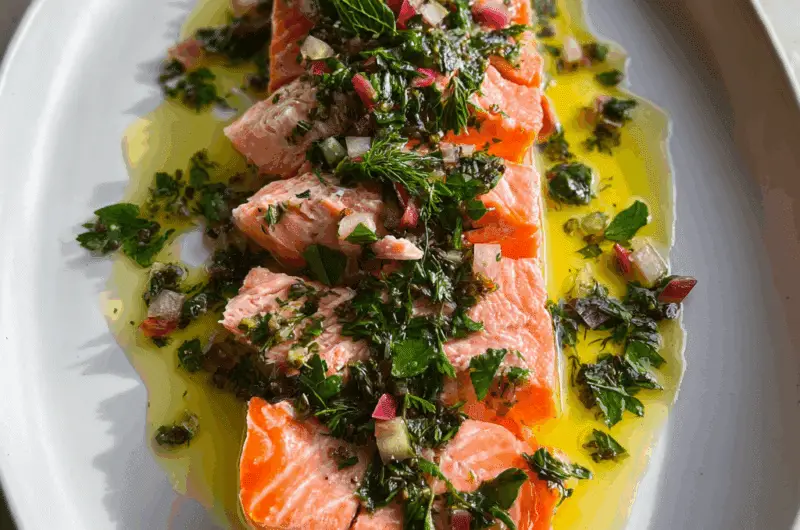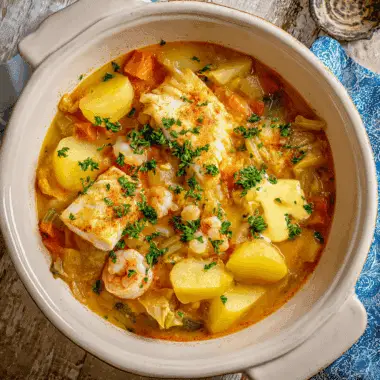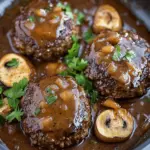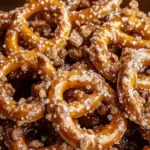Savor the elegance of this Olive Oil Poached Salmon with Herb Vinaigrette—a dish that marries silk‑like fish with a punchy, vibrant dressing. Poached gently in extra‑virgin olive oil at a low temperature, the salmon retains moisture and delicate texture. Each bite is buttery and refined, perfect for a special dinner for two or a relaxed gourmet meal.
The herb vinaigrette—infused with parsley, basil, chives, shallot, lemon, and a touch of heat from chili—lends brightness and freshness to the dish. Paired with crisp salad greens, it transforms simple ingredients into a beautifully balanced, visually appealing entrée. Elegant yet approachable, this recipe showcases how minimal techniques reveal maximum flavor.
Full Recipe
Ingredients:
-
1 lb boneless skinless salmon filet
-
4 cups cold water
-
½ cup coarse kosher salt
-
4 cups extra‑virgin olive oil
-
2–4 cups mixed salad greens
Herb vinaigrette:
-
1 Tbsp flat‑leaf parsley, chopped
-
1 Tbsp chives, chopped
-
1 Tbsp basil, chopped
-
1 Tbsp shallot, minced
-
1 Tbsp red chili pepper, minced
-
1 Tbsp lemon zest and 1 Tbsp lemon juice
-
2 Tbsp white wine vinegar
-
1 tsp Dijon mustard
-
½ tsp salt and ½ tsp pepper
Directions:
-
In a sauté pan over very low heat, gently warm the olive oil until it reaches about 140°F.
-
Meanwhile, stir salt into cold water until fully dissolved. Cut the salmon filet in half and immerse in the salted water for 5 minutes.
-
Remove salmon, pat dry, then slide into the warm olive oil. Poach gently for 10–15 minutes until the internal temperature hits approximately 125°F.
-
While the fish cooks, mince all the herbs, shallot, and chili pepper. Combine with lemon zest, lemon juice, vinegar, mustard, salt, and pepper in a jar—whisk or shake well.
-
Divide salad greens between two plates. Gently transfer the poached salmon onto the greens. Drizzle each plate with the herb vinaigrette and serve immediately.
Prep Time: 10 minutes | Cooking Time: 15 minutes | Total Time: 25 minutes
Kcal: approx. 550 kcal per serving | Servings: 2
The Art of Olive Oil Poaching
Olive oil poaching is a refined culinary technique that has been used in Mediterranean kitchens for generations. Unlike water-based poaching, which can dilute flavors, olive oil poaching gently cooks proteins in a rich, flavorful fat that enhances moisture and texture. This method produces silky, tender results, especially when working with delicate proteins like fish. The low and slow cooking process—usually at temperatures around 140°F—ensures that the fish is never overcooked and maintains its natural succulence.
In this particular dish, salmon is submerged in high-quality extra-virgin olive oil, which acts not only as a cooking medium but also as a flavor enhancer. This method is less about searing or crisping and more about nurturing the fish, preserving its integrity while giving it a luxurious mouthfeel.
Why Salmon Works So Well with Olive Oil
Salmon is an ideal choice for olive oil poaching due to its rich fat content and bold flavor profile. When gently cooked in olive oil, salmon’s natural oils blend harmoniously with the richness of the poaching liquid, producing a melt-in-your-mouth texture. The result is tender, almost buttery fillets that flake apart with the slightest touch of a fork.
Moreover, the oil acts as a conductor that evenly distributes heat, helping the salmon cook uniformly without the risk of drying out. This method also eliminates the need for excessive seasoning or complex preparation—the simplicity of the ingredients allows the true essence of the salmon to shine through.
The Role of the Brine
An important step in this recipe is the five-minute brine the salmon undergoes before poaching. Using a basic saltwater solution, this step seasons the fish from within, enhances flavor, and firms up the flesh, making it easier to handle during the poaching process. It’s a subtle but crucial preparation step that elevates the overall dish from good to exceptional.
This quick brining process not only adds complexity to the taste but also helps reduce albumin—the white protein that can appear on the surface of cooked salmon—resulting in a cleaner, more attractive presentation.
What Makes the Herb Vinaigrette Stand Out
The fresh herb vinaigrette is what turns this from a simple poached salmon dish into a complete, restaurant-quality plate. A blend of parsley, basil, and chives forms the aromatic backbone of the vinaigrette, while shallots and red chili peppers bring depth and a hint of heat. The lemon zest and juice add brightness, and the white wine vinegar ties everything together with a subtle tang.
This vinaigrette acts as both a flavor accent and a sauce. Instead of masking the salmon, it enhances the fish’s natural richness with layers of acidity, herbal freshness, and mild spice. It’s light enough not to overpower the dish, but bold enough to balance the buttery texture of the poached salmon.
Serving Suggestions and Plating Tips
Presentation plays a key role in this dish’s appeal. Typically, the salmon is served over a bed of mixed greens, which adds a fresh crunch and helps absorb some of the vinaigrette, creating a harmony between the warm fish and the cool salad elements. Plating is best kept minimal and elegant—let the soft coral hue of the salmon contrast with the bright green herbs and vibrant red flecks of chili.
You can also add roasted baby potatoes or a chilled grain salad such as farro or quinoa as sides, making this dish suitable for a more filling lunch or light dinner. For plating at a dinner party or formal gathering, consider garnishing with microgreens or edible flowers for a refined, colorful presentation.
Health Benefits of Olive Oil Poached Salmon
One of the most compelling reasons to try olive oil poaching—besides its culinary elegance—is the health factor. This technique avoids processed fats, and when using high-quality extra-virgin olive oil, you’re introducing heart-healthy monounsaturated fats into the dish. Olive oil has been linked to reduced inflammation, improved cardiovascular health, and better digestion.
Salmon itself is a powerhouse of nutrition. Rich in omega-3 fatty acids, protein, B vitamins, and antioxidants like astaxanthin, it’s a smart choice for maintaining brain and heart health. By gently poaching it instead of pan-frying or grilling, you’re preserving more of these nutrients, making it a nourishing choice for any health-conscious eater.
Customizations and Variations
This dish is incredibly versatile. You can swap out the herbs based on what’s fresh or available—try tarragon for a slightly licorice-like flavor, or dill for a more Scandinavian vibe. The vinaigrette can also take on different forms depending on your preferences. Swap white wine vinegar for sherry vinegar or add a touch of honey for sweetness.
Want to add a protein-rich element? Try crumbling a bit of feta or adding slices of hard-boiled egg to the salad. If you’re cooking for guests who prefer milder heat, simply omit the red chili and increase the shallots for an equally flavorful, more gentle variation.
You can also make the vinaigrette ahead of time and store it in the fridge for up to three days, allowing the flavors to marry even more deeply.
When to Serve This Dish
Olive Oil Poached Salmon with Herb Vinaigrette is ideal for a variety of occasions. It’s light yet satisfying, making it perfect for warm-weather dinners, bridal showers, brunches, or even a romantic dinner for two. Because it can be served slightly warm or at room temperature, it’s also a great choice for entertaining—no last-minute stress at the stove required.
It’s also an elegant lunch option when paired with a crusty piece of sourdough or baguette, giving you a meal that feels both indulgent and fresh.
Storing and Leftovers
While best enjoyed freshly made, leftover poached salmon can be stored in the refrigerator for up to two days. Because it’s already cooked gently, it won’t dry out as quickly as grilled or baked salmon when reheated. However, to preserve the delicate texture, it’s best served cold or gently warmed.
Leftover salmon also makes a wonderful topping for grain bowls or even as a flaked protein in a Mediterranean-inspired wrap or sandwich. The herb vinaigrette can be used as a dressing for roasted vegetables, grilled chicken, or even as a bright sauce for pasta.
Conclusion
Olive Oil Poached Salmon with Herb Vinaigrette is more than just a recipe—it’s an experience. It’s a celebration of refined technique, quality ingredients, and culinary simplicity. This dish teaches us that sophistication doesn’t require complexity. With just a few steps and a handful of fresh, wholesome ingredients, you can create a meal that feels luxurious, nourishing, and absolutely delicious.
Whether you’re cooking for yourself or hosting guests, this dish offers a chance to slow down, savor the process, and serve something truly special. From its silky texture to its zesty herbaceous finish, this poached salmon is the kind of recipe that reminds us why we love to cook—and share food—in the first place.








